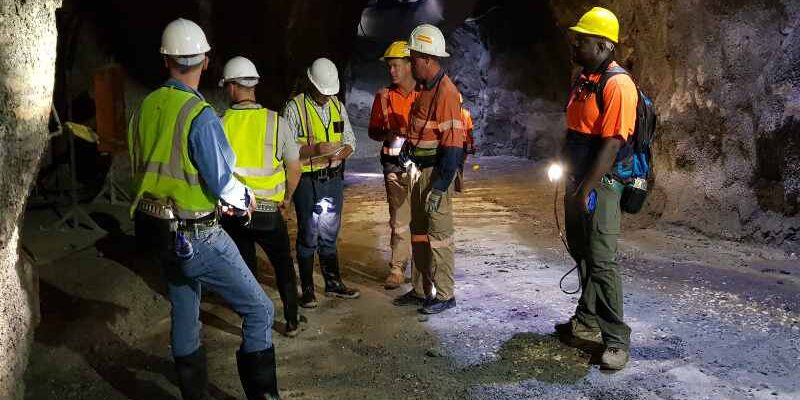ALPHAMIN RESOURCES – KEYSTONE OF THE 4TH INDUSTRIAL REVOLUTION
Alphamin Resources is a mainstay bridging the world of rapidly developing technology and the remote territory in DRC’s North Kivu jungles.
Alphamin has built, commissioned, and for over a year has been producing tin from its Mpama North mine at Bisie in North Kivu DRC. Alphamin’s operation is a pinprick in the vast jungles of North Kivu DRC, however, its comparative size belies the gigantic role it has and continues to play in the two extreme poles of the rapidly developing fourth industrial revolution and renewable energy sectors, and the dramatic improvement in the livelihoods of its host communities in North Kivu DRC.
Alphamin represented the most important source for tin, the glue that enables the 4th Industrial Revolution,” says Maritz Smith, Alphamin CEO. “Its location presented certain challenges, which having been successfully met, positions the company as a pillar of strength in North Kivu, DRC whilst becoming a mainstay supplier of tin to the world .”
While the mine presented a challenge, the growing demand for tin made the effort to overcome those challenges worth it.

“Tin has been mined and used by mankind for millennia. It is a metal that seldom occurs in deposits with a grade sufficient to support a mining operation. Yet tin plays a vital role in the world’s current economic activities, whilst proving to have a vast array of pivotable future uses in new technologies particularly renewable energies,” Boris Kamstra, Alphamin Executive Director tells us. “This demand, which promises only to increase, is in stark contrast to the rapidly depleting current mines, and few new mines.”
COVID-19 has placed further pressure on a smooth, predictable volume of mined tin for its end users. The pandemic has induced shutdowns reducing the supply of new material available to the market, whilst at the same time delaying the progress of new operations. In this environment, Alphamin is a new pillar of reliable predictability for the industry’s end users.
“Despite the challenges posed by COVID-19, Alphamin has consistently met and in instances surpassed its market guidance,” Smith says proudly. “This is just the beginning, as the company has announced plans to increase production, reduce the cost of tin produced and increase the resources to support and increase the current life of mine for Bisie and other prospects on Alphamin’s license area.”
Alphamin secured a license covering an area known as Bisie. Located in remote equatorial rain forests of the Walikale Territory of North Kivu DRC. Logistics and associated infrastructure initially presented a challenge. However, the Alphamin team with the backing of its shareholders recognised the potential and believed solutions would be found to those challenges.
“Bisie’s indicative grades would be worth the effort, and the team’s ingenuity would surpass all obstacles in the way of developing the mine,” Kamstra says. “The world’s tin mines currently have an average head feed grade of 0.8% tin, Alphamin in comparison has a head feed grade of 4.1% tin. This translates roughly into the rest of the world having 8kg of tin available per tonne of ore mined versus Alphamin having 41kgs available. That is 5.13 times as much, or 412.5% more tin available pre-processing for Alphamin than the global average.”
Alphamin believed that these grades would be more than sufficient to deal with the additional costs of establishing and operating this remote mine. This belief has been verified with Alphamin consistently ranked in the lowest cost quartile of tin mines globally.
These high in situ grades and process friendly mineralisation allowed Alphamin to design and construct an efficiently sized operation comprising an underground mine with a concentrating plant to produce 11,000 tonnes of tin in concentrate per annum.
Alphamin announced in July this year that it will be initiating Resource Extension Drilling at its Mpama South prospect. This is less than one kilometre away from its current processing facility. Between 2012 and 2013 Alphamin drilled 19 holes to determine the extent and nature of mineralisation at Mpama South. This programme intersected two distinct mineralised zones, an upper zone showing well-developed lead, zinc and silver mineralization, and a lower zone rich in tin and copper. A deep-level drilling program is being initiated to further target additional resources for the current mining operation.
Whilst Mpama North and South are targets for drilling later in 2020 and 2021, Alphamin has several additional targets along the Bisie Ridge where geochemistry and geophysics have returned signatures resembling those of Mpama North.
“The efficiency of the processing plant will be improved with the addition of a fine tin recovery circuit,” Smith explains. “This has the potential to raise Alphamin’s tin production to 12,000 tonnes per annum at a negligible cost.”
The Future is Tin
“Tin’s current primary use is in electronic solder, the glue that holds the technology world together. All components are secured to their respective circuit boards with tin,” Kamstra says.
Kamstra is right. Not only is tin is in every mobile phone, computer, and television screen, it’s also seeing growing use in motor vehicles, both Electronic Vehicles(EV) and internal combustion engines. Estimates are that by 2040 half of all passenger vehicles will be EV. According to the International Tin Association, the metal will increasingly contribute to modern, clean technologies including lithium-ion batteries for autonomous and EVs.

“Battery researchers are developing solid-state batteries utilising ceramic electrolytes (versus liquid) for improved safety and performance,” Kamstra points outs. “Silicon is a potentially attractive anode material due to its high potential capacity and abundance in nature. Recent research has shown that adding tin to the silicon-based anode enhances its performance, creating the potential for tin to be a major contributor to the next generation of lithium batteries.”
Tin is increasingly being incorporated into solar panels, replacing scarce and increasingly expensive rare earth elements. Bloomberg estimates that 12TW increase in generating capacity will be required by 2050, with close to 80% of this coming from renewable energy sources. In solar energy alone close to 500g of tin is required for 1MW of solar power.
Tin’s importance to the world economy was recently highlighted when the USA declared tin a critical strategic metal. According to a 2018 U.S. Geological Survey tin has not been produced in the United States since 1993.
Alphamin’s Bisie tin mine in the DRC is well-positioned to take advantage of the world’s growing demand for “clean” minerals.
“The Bisie project in the DRC is an excellent example of how to go about mining in developing countries and building relationships with all stakeholders,” Kamstra says. “Moreover, the company’s drive to find additional ore bodies at Bisie, means that its hosts of Walikale, shareholders and users of tin will benefit from Alphamin’s operations well into the future”, concludes Smith.
![]()





